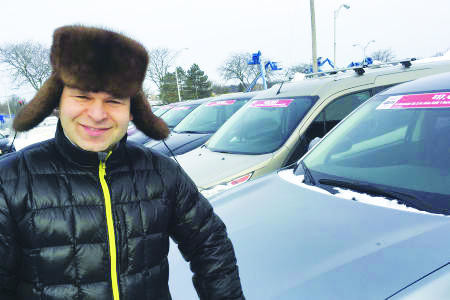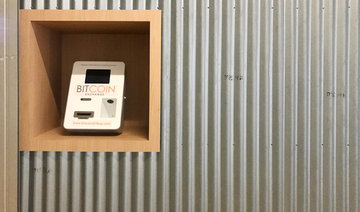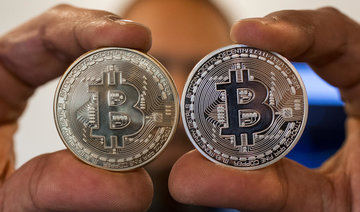NEW YORK: Bitcoins can buy you a TAG Heuer watch, a cross-country flight or a meatball marinara sub.
Purchases with bitcoin and other digital currencies remain rare relative to cash and credit cards. Many bitcoin holders value it more as an investment than a day-to-day currency.
And the complex workings behind the notoriously volatile currency can be off-putting to neophytes. What are the fees? Are there taxes? How do you spend a currency that can devalue dramatically between ordering appetizers and paying the check?
Buying with bitcoin can be as easy as tapping your phone, though there are some cautions. A look at a single bitcoin transaction, the sale of a 2017 Subaru from an upstate New York car dealer to a buyer from Virginia, offers some insights into the currency’s uses.
IN BUSINESS WITH BITCOIN
Eugene Rubinchuk didn’t get into digital currency for the anonymity or to strike a blow against centralized banking. He was just looking for more business.
Rubinchuk and his father, who goes by “Mike the Russian,” already ham it up in local TV commercials for Michael’s Auto Plaza wearing furry hats. Digital currency is just another potential edge.
“It’s just a way to reach customers we normally couldn’t reach, that normally wouldn’t think of us,” he said.
The cars and truck on the lot near Albany are priced in US dollars. Rubinchuk simply signed up for one of the services that allowed him to accept digital currencies if a bitcoin buyer came along.
CASHING IN CRYPTOCURRENCY
Jonathan Cypert got into bitcoin early and made out well.
In 2011, he read about a 2-year-old currency skyrocketing in value and soon invested $2,000 in computers to “mine” bitcoins for about a year and a half. That’s the complicated process that rewards tech-savvy participants for verifying bitcoin transactions in its public ledger, called the blockchain.
When he started, a single bitcoin was worth around $2.50. By the time he was ready to buy a used, low-mileage Subaru for his wife, a bitcoin was worth over $14,000.
The 32-year-old Virginia resident sees his bitcoin cache as a nest egg to tide him over after he retires from the military. (Wary of attracting scammers, Cypert requested that his hometown and military branch not be made public). The purchase gave him a chance to recoup his investment many times over with a fraction of his cache.
“At this point it’s like, why not?” Cypert said. “I might as well realize some of that gain.”
BITCOIN BARGAINING
Rubinchuk and Cypert talked on the phone on the evening of Jan. 2 and settled on a sale price on the Subaru WRX STI of $34,640.
Then they had to agree on what that equaled in bitcoins judging by the exchange rates that moment. Tracking bitcoin prices on their screens, the pair agreed to proceed with one bitcoin equaling about $14,755. Cypert sent 2.34790481 bitcoins from his personal electronic wallet to the public address of Rubinchuk’s wallet.
Cypert also paid a fee of about $3.50, which goes to reward miners and keep the system running.
Then Rubinchuk watched bitcoin’s value go up and down as he waited to convert his digital money into dollars.
BLOCKCHAIN BLUES
Rubinchuk wanted to convert quickly in case bitcoin’s value suddenly dropped against the dollar, costing him money. The fear is well-founded, since bitcoin’s value can gain or lose more than $400 in a half-hour.
But the digital currency service he uses required him to wait for multiple confirmations from the bitcoin network before he could convert it into dollars, a process that can be affected by network congestion and other factors. Rubinchuk recalls waiting about 30 to 45 minutes.
“I’m sitting there on pins and needles checking every five minutes if it’s available,” he said.
Rubinchuk converted the sale into dollars with bitcoin just slightly below where it was at the time of the sale earlier that evening. He made about $7 less than the sale price.
The money was in his business’s bank account within 48 hours.
Rubinchuk soon after signed up for a separate merchant account through another provider that assesses him a 1 percent fee on all transactions, insulating him from short-term volatility. He compares it favorably to credit card fees that run 2 to 3 percent for merchants.
KEEPING IT LEGAL
Digital currencies are notoriously used by criminals to transfer funds anonymously. But Rubinchuk told the tax collector about this transaction.
In a standard IRS form for cash payments over $10,000, he reported the money he received, from whom it came and the fact that it originated “via bitcoin.”
Cypert avoided sales tax under a federal law covering service members that lets him retain his official residency in Alaska, which does not have a sales tax.
But he will pay taxes on a long-term capital gain.
YOUR TIME MAY VARY
Bitcoin miner fees have dropped markedly this year, and advocates say congestion issues are being solved by new technologies. Rubinchuk waited about 15 minutes to make a dollar exchange last week for his second bitcoin sale, a 2016 Hyundai Elantra.
And recently in Hillsboro, Oregon, Jeff Hanzlik bought $288 worth of marijuana-growing supplies from a store in a transaction that took a few minutes to finalize. He transmitted 0.03305451 in bitcoins from his phone, which read a code on the merchant’s tablet. The same phone app allowed Hanzlik to choose to pay about a quarter in fees.
“Once you understand what this technology is and this genie’s out of the bottle, you’re not going to have any choice but to be using it in the future,” Hanzlik said.
But the bitcoin network at this stage is still not suited to smaller, everyday transactions, said Christian Catalini, founder of the Massachusetts Institute of Technology’s Cryptoeconomics Lab.
“If you’re thinking about paying for coffee in bitcoin, that’s not what it’s good at right now,” he said. “Things can change.”
Bitcoin: Anatomy of a transaction
Bitcoin: Anatomy of a transaction

Saudi banks’ funding profile changing on rising mortgage demand: S&P Global

RIYADH: Saudi banks are expected to pursue alternative funding strategies to deal with the rapid expansion in lending, fueled by the demand for new mortgages, according to S&P Global.
In its latest report, the credit-rating agency stated that the funding profiles of financial institutions in the Kingdom are set to undergo changes, primarily driven by a state-backed initiative to boost home ownership.
According to the analysis, mortgage financing represented 23.5 percent of Saudi banks’ total credit allocation at the end of 2023, compared to 12.8 percent in 2019.
“The ongoing financing needs of the Vision 2030 economic initiative and relatively sluggish deposits growth, is likely to incentivize banks to seek alternative sources of funding, including external funding,” said S&P Global.
The report also predicted that this pursuit of external funding could potentially impact the credit quality of Saudi Arabia’s banking sector.
According to the US-based rating agency, lending growth among Saudi banks has outpaced deposits, with the loan-to-deposit ratio exceeding 100 percent in 2022, up from 86 percent at the end of 2019.
S&P Global expects this trend to persist, particularly with corporate lending playing a more significant role in growth over the next few years. “We consider Saudi banks are likely to turn to alternative funding strategies to fund that expansion,” the report said.
HIGHLIGHTS
100%
According to the US-based rating agency, lending growth among Saudi banks has outpaced deposits, with the loan-to-deposit ratio exceeding 100 percent in 2022, up from 86 percent at the end of 2019.
It added: “We consider, however, that the risk created by the maturity mismatch is mitigated by the relative stability of Saudi deposits.” The agency also predicted that Saudi banks’ foreign liabilities will continue to increase, rising from about $19.2 billion at the end of 2023 to meet the funding requirements of strong lending growth, particularly amidst lower deposit expansion.
The report highlighted that Saudi banks have already tapped international capital markets, and the credit rating agency expects this trend to continue for the next three to five years.
According to S&P Global, the Saudi banking system could transition from a net external asset position of SR42.9 billion, or 1.6 percent of lending, at the end of 2023 to a net external debt position within a few years.
In April, S&P Global, in another report, stated that banks in the Kingdom are anticipated to experience robust credit growth ranging between 8 to 9 percent in 2024.
The agency noted that this credit expansion will be propelled by corporate lending, fueled by increased economic activities driven by the Vision 2030 program.
Moreover, the report added that the Saudi government and its related entities are expected to inject deposits into the banking system, thereby supporting the credit growth of financial institutions in the Kingdom.
NEOM, Saudi Red Sea Authority sign MoU to develop marine tourism regulations

- The MoU’s goal is to enhance research, deliver innovation, and improve the visitor experience for tourists
- The agreement reflects SRSA’s commitment to attracting investment in coastal tourism activities
NEOM: The Saudi Red Sea Authority and NEOM signed a memorandum of understanding on Friday to cooperate on developing legislation, regulations, and technology in marine tourism, reported the Saudi Press Agency.
The MoU’s goal is to enhance research, deliver innovation, and improve the visitor experience for tourists in Saudi Arabia’s existing, emerging, and future Red Sea coastal destinations.
SRSA Acting CEO Mohammed Al-Nasser and NEOM’s CEO Nadhmi Al-Nasr signed the partnership, which they hope will promote an exchange of expertise and enable the implementation of joint initiatives.
The agreement also reflects SRSA’s commitment to attracting investment in coastal tourism activities.
The partnership will further assist small and medium enterprises in the sector through administrative, technical, and advisory support.
Via this agreement, SRSA aims to integrate with relevant public, private, and third-sector entities to achieve one of the goals of Saudi Vision 2030, which is to develop coastal tourism as a valuable sector of the Kingdom’s economy.
World food prices up in April for second month: UN agency

PARIS: The UN food agency’s world price index rose for a second consecutive month in April as higher meat prices and small increases in vegetable oils and cereals outweighed declines in sugar and dairy products.
The Food and Agriculture Organization’s price index, which tracks the most globally traded food commodities, averaged 119.1 points in April, up from a revised 118.8 points for March, the agency said on Friday.
The FAO’s April reading was nonetheless 7.4 percent below the level a year earlier.
The indicator hit a three-year low in February as food prices continued to move back from a record peak in March 2022 at the start of Russia’s invasion of Ukraine.
In April, meat showed the strongest gain in prices, rising 1.6 percent from the prior month.
The FAO’s cereal index inched up to end a three-month decline, supported by stronger export prices for maize. Vegetable oil prices also ticked higher, extending previous gains to reach a 13-month high due to strength in sunflower and rapeseed oil.
The sugar index dropped sharply, shedding 4.4 percent from March to stand 14.7 percent below its year-earlier level amid improving global supply prospects.
Dairy prices edged down, ending a run of six consecutive monthly gains.
In separate cereal supply and demand data, the FAO nudged up its estimate of world cereal production in 2023/24 to 2.846 billion metric tonnes from 2.841 billion projected last month, up 1.2 percent from the previous year, notably due to updated figures for Myanmar and Pakistan.
For upcoming crops, the agency lowered its forecast for 2024 global wheat output to 791 million tonnes from 796 million last month, reflecting a larger drop in wheat planting in the EU than previously expected.
The revised 2024 wheat output outlook was nonetheless about 0.5 percent above the previous year’s level.
Material sector dominates TASI trading in first quarter of 2024

RIYADH: The materials sector led trading on Saudi Arabia’s Tadawul All Share Index, accounting for approximately SR87 billion ($23.2 billion) or 15.11 percent of the market, according to TASI’s 2024 first-quarter report.
SABIC, the largest component of this sector, boasted a market capitalization of SR234.9 billion, with trading value reaching nearly SR7 billion.
The banking sector trailed with transactions valued at SR71.22 billion, comprising 12.37 percent of the market. Al-Rajhi Bank took the lead in market capitalization within the sector and secured the second spot in trade value totaling SR23.62 billion.
In a February report by Bloomberg, Al-Rajhi Bank, seen as an indicator of Saudi Arabia’s growth strategies, exceeded the performance of JPMorgan Chase & Co., exhibiting nearly a 270 percent surge in shares since the initiation of Vision 2030. It has outpaced both local and global competitors, including state-supported banks, emerging as the largest bank in the Middle East and Africa, boasting a market cap of around $95 billion.
According to Morgan Stanley analysts led by Nida Iqbal, as reported by Bloomberg, “We see it as a long-term winner in the Saudi bank sector… While Al-Rajhi is best placed for a rate-cutting cycle, we believe current valuation levels reflect this.”
Gulf central banks, including Saudi Arabia’s, frequently align their policies with those of the Federal Reserve to maintain their currency pegs to the dollar. According to Bloomberg Intelligence senior analyst Edmond Christou, a reduction in Fed rates could potentially bolster Al-Rajhi Bank’s profitability and expansion, as it will encourage gathering cheap deposits while enabling it to issue debt at more attractive levels.
In this period, the energy sector secured the third position in terms of value traded, reaching SR55.4 billion. Saudi Aramco topped the list with a market capitalization of SR7.47 trillion and registered the highest value among companies traded on the index, totaling SR28.82 billion.
In March of this year, Aramco announced a net income of $121.3 billion for its full-year 2023 financial results, marking the second-highest in its history. Aramco credited these results to its operational flexibility, reliability, and cost-effective production base, underscoring its dedication to delivering value to shareholders.
Tadawul’s quarterly report also indicated that the transportation sector recorded the fourth-highest value traded at SR39.25 billion, equivalent to 6.82 percent of the market. Among the top performers in this sector was cargo firm SAL Saudi Logistics Services, ranking third in value traded on the TASI during this period, following Aramco and Al-Rajhi Bank, with a total value of SR22.74 billion.
SAL debuted on the main market of the Saudi Exchange in November last year. With aspirations to manage 4.5 million tonnes of air cargo by 2030, Saudi Arabia is empowering its logistics sector from a supportive role to a pivotal driver of economic growth.
SAL, in which the Saudi government holds a 49 percent stake through the Saudi Arabian Airlines Corp., experienced a 30 percent surge in its share price during its initial public offering, raising $678 million and becoming Saudi Arabia’s second-largest IPO of the year.
In a January report by Forbes, SAL’s CEO and Managing Director Faisal Al-Beddah emphasized the company’s potential to shape the future of logistics in Saudi Arabia and beyond. He stated: “Logistics is the backbone of any economy. Now we are ready. We have the rotation, we have the infrastructure, we have the regulations, and most importantly, we have the mindset and the technology for Saudi Arabia to be the leading connecting logistics hub in the region.”
The top gainer during this period in terms of price appreciation was MBC Group, with a quarter-to-date percentage change of 127.6 percent, according to Tadawul.
Saudi Arabia’s MBC Group, a media conglomerate, debuted as the first new listing on TASI in 2024. Its trading began on Jan. 8. The company raised SR831 million through its initial public offering.
Saudi Steel Pipes Co. in the materials sector was the second highest gainer, with price appreciating by 88.15 percent.
Etihad Atheeb Telecommunication Co. had a QTD price percentage change of 81.91 percent making it the third-highest gainer on the exchange during this period.
TASI concluded the first quarter of 2024 with a 3.6 percent increase, climbing by 435 points to reach 12,402 points.
Saudi startups raised $3.3bn in last 10 years, says report

- MAGNiTT report shows fintech emerged as the most funded sector in Kingdom
RIYADH: Startups in Saudi Arabia saw massive growth during the last decade raking in $3.3 billion in venture capital funding, according to a report issued by MAGNiTT.
The data platform, in its “10 Years Saudi Arabia Founders Report” sponsored by Saudi Venture Capital Co., provides an in-depth analysis of the backgrounds, experiences, and expertise of founders.
“MAGNiTT initially published a report on founders in the MENA VC ecosystem in 2018, focusing on uncovering the DNA of successful entrepreneurs in the region. Today, in partnership with the Saudi Venture Capital Co., we present a comprehensive report on the founders of the top 200 funded startups in the Kingdom over the last ten years,” said Philip Bahoshy, CEO and founder of the platform.
“By shedding light on founders’ experiences in the Saudi ecosystem, we aim to dispel myths around founders, empower aspiring entrepreneurs looking to establish their ventures in the Kingdom, guide government decision-makers in shaping policies conducive to innovation, and provide invaluable intelligence to investors seeking opportunities in the region,” he added.
SVC CEO Nabeel Koshak emphasized the remarkable growth and dynamism in the Saudi startup landscape.
FASTFACTS
Forty-four percent of these startups were launched by teams with two founding members, who together secured 53 percent of the total funds.
Startups founded by a single individual accounted for 30 percent of the funded startups but only captured 15 percent of the funding in the last decade.
Thirty-six percent of the 400 founders analyzed had at least 10 years of work experience before launching their respective startups.
Fifty-nine percent of founders had technical education backgrounds, highlighting science, technology, engineering, and mathematics.
Thirty-nine percent of founders held degrees in business, contrasting with the global average of 19 percent, according to an Endeavor Insight study.
“The Kingdom’s strategic initiatives, driven by the Saudi Vision 2030, have laid a solid foundation for innovation, entrepreneurship, and investment. As a result, we have seen a surge in startup activity, with a growing number of ambitious founders seizing opportunities and driving innovation across various sectors,” he said.
“The goal of the report is to provide policymakers, government officials, and investors with insights and data to inform strategic decisions and policies to further nurture the startup ecosystem for the next 10 years,” Koshak added.
A decade of funding
Compiling data from the 200 Saudi-based startups, which collectively raised a total of $3.3 billion from 2014 to 2023, the report highlighted that 44 percent of these startups were launched by teams with two founding members, who together secured 53 percent of the total funds.
He further stated that with the significant support for innovation, the Kingdom is set to witness the emergence of more unicorns.
In contrast, startups founded by a single individual accounted for 30 percent of the funded startups but only captured 15 percent of the funding in the last decade.
Notably, 36 percent of the 400 founders analyzed had at least 10 years of work experience before launching their respective startups.
The report also indicated a trend toward entrepreneurship among less experienced founders, with 66 percent being first-time startup founders and only 30 percent with previous regional startup experience.
It revealed a significant gender disparity in the VC landscape within Saudi Arabia, with male founders comprising 94 percent of the total 400 individuals, while female founders accounted for only 6 percent.
This gender gap is considerably wider than the global norms, where, according to research by Startup Genome conducted between 2016 and 2022, the average proportion of female founders in an ecosystem was 15 percent.
Additionally, only 7 percent of solo founders were female, and there were no recorded startups with two or more female founders only.
However, as the number of founders per startup increased, so did gender diversity, albeit slightly. In startups with three founders, 18 percent were of mixed gender, while in startups with four or more founders, the figure was 12 percent.
Furthermore, 91 percent of male-only founded startups claimed 98 percent of total funding. Conversely, 3 percent of female-only founded startups accounted for 0.4 percent of the total funding.
Founders' education
The report further delved into the education qualification of founders revealing that 55 percent in the Kingdom had attained at least a bachelor’s degree.
In terms of technical development, 59 percent of founders had technical education backgrounds, highlighting science, technology, engineering, and mathematics.
Thirty-nine percent of founders held degrees in business, contrasting with the global average of 19 percent, according to an Endeavor Insight study.
Over half of the 400 founders obtained their degrees internationally, while 22 percent held both international and local degrees.
King Saud University, King Fahd University of Petroleum and Minerals, and King AbdulAziz University were among the most common institutions for startup founders.
Seven of the top 10 universities of Saudi founders that raised funding were public institutions.
The top international schools of Saudi founders had Stanford and Harvard among the top choices, mirroring global trends.
Professional experience
Despite fintech being the most funded sector, only 7 percent of founders had experience in finance, and 18 percent in banking, which is lower compared to the 48 percent with backgrounds in information technology.
Additionally, even fewer founders, only 12 percent, had experience in e-commerce, despite this industry accounting for the highest share of deals, 20 percent, closed by the top 200 Saudi startups.
The report also revealed that 36 percent of the founders in Saudi Arabia are skilled professionals with over 10 years of experience before starting their businesses.
Notably, Saudi Aramco was the most common previous employer among the funded founders, with 7 percent having worked there before launching their startups.
Furthermore, McKinsey and Microsoft were among the top 10 companies where the 400 founders covered in this report had previously been employed.
The majority of these founders held significant leadership roles, with 31 percent having served as a founder, co-founder, or board member. Only 4 percent originated from entry-level positions.
The report also pointed out: “While Saudi Arabia has witnessed several serial entrepreneurs, 66 percent of founders in the last decade were first-time founders,” indicating a vibrant and growing entrepreneurial ecosystem.
















